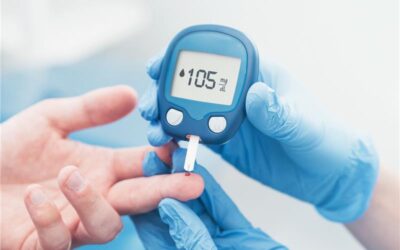Case Study
The Impact of Probiotic Supplementation on Low Bone Mineral Density (BMD)
Supplementation of the probiotic L. reuteri led to an increase in the serum levels of key amino acids that may regulate bone metabolism in older women.
Metabolomics identified a number of potential biomarkers that link changes in the gut microbiota to changes in metabolomics that affect bone metabolism in aging women.
Metabolomics identified a number of potential biomarkers that link changes in the gut microbiota to changes in metabolomics that effect bone metabolism in aging women.

The Challenge: Is Probiotic Supplementation for Treatment of Osteoporosis Linked to Changes in Gut Microbiome Metabolite Production?
Osteoporosis is a common disease primarily affecting older populations, characterized by reduced bone mineral density (BMD) which leads to increased susceptibility of fragility fractures.1 Previous studies have identified that gut microbiota is key regulator of bone metabolism.2 Supplementation with the probiotic bacteria, Lactobacillus reuteri has been shown to reduce bone loss and increase bone density in mice with estrogen deficiency or increased inflammation.3,4 The authors of this study showed previously that supplementation of L. reuteri could reduce bone loss by approximately 50% in older women with low BMD.5 In mice, the supplementation with probiotics has been linked to the production of short chain fatty acids in the intestine, but the mechanism in human metabolism is unclear.6 Prior to this study no one had directly studied metabolomic changes and its effect on human bone metabolism in response to probiotic supplementation in humans.
Metabolon Insight: Untargeted Metabolomics Identify Global and Specific Metabolic Changes Correlated with Higher Bone Mineral Density
This study focused on 68 elderly women with osteopenia: 32 assigned randomly to supplementation with L. reuteri, and 36 assigned to supplementation with a placebo. Serum was collected at baseline and at 3, 6, and 12 months. The Metabolon Global Discovery Panel identified 1,232 metabolites, 958 which were compounds of known identity. The researchers found that there was almost no difference in metabolite levels in the group treated with L. reuteri over the different time points, indicating low metabolic variation. In the placebo group however, there were noticeable differences over the different time points, indicating higher metabolic variation. 97 metabolites were identified that were different between the L. reuteri and the placebo group at any one time point. A number of these metabolites are known to be associated with amino acid, peptide, and lipid metabolism. Two metabolites were significantly different at all three time points—butyrylcarnitine (C4) and 1-methyl-4-imidazoleacetate, both of which are involved in amino acid metabolism. A handful of identified metabolites were correlated to patients volumetric BMD (vBMD) at both baseline and after 12 months. The only metabolite that was positively correlated with vBMD at both timepoints was isovalerylcarnitine (C5), another molecule involved in amino acid metabolism.
The researchers also performed a cross-sectional study in which 240 women were selected, 120 with the highest tibia vBMD and 120 with the lowest tibia vBMD out of a cohort of more than 3,000. The Global Discovery Panel identified 104 differential metabolites between the two groups, 23 of them higher and 81 lower in the women with low vBMD. Further analysis found 38 relevant pathways that use these metabolites, mainly amino acid metabolism and steroid hormone biosynthesis, butanoate metabolism, and citrate-acid cycle. Steroid hormone biosynthesis changes are consistent with studies that show that steroid hormones influence bone metabolism through regulation of osteoclast and osteoblast cells.7
The Solution: Amino Acid and Steroid Hormone Metabolism Play a Key Role in Stimulating Bone Metabolism
The results of this study highlight that supplementation of the probiotic L. reuteri leads to an increase in the serum levels of key amino acids that may regulate bone metabolism in older women. In particular, branched chain amino acids (BCAAs) and their derivatives were significantly increased in patients with L. reuteri supplementation. Since BCAAs are part of the gamma-glutamyl amino acid cycle, BCAAs could be stimulating osteoblast differentiation through activation of the mTORC1 complex (directly or indirectly).8,9 When comparing patients with high BMD vs. patients with low BMD, the researchers identified significant differences in both BCAAs and steroid hormone biosynthesis. Both studies identified changes in key metabolites affecting amino acid metabolism, which has been shown to play a vital role in bone metabolism.
12 metabolites were identified as significantly different in both metabolomic studies, with isovalerylcarnitine (C5), TMAP, and valine all higher in the high BMD group compared to the low BMD group. This supported the previous findings showing an increase in these metabolites after supplementation with L. reuteri. Additionally, the researchers found there was a correlation between isovalerylcarnitine (C5) and total tibia vBMD at both baseline and 12 months after supplementation. The increased levels of butyrylcarnitine (C4) from the first study suggests that butyrylcarnitine’s role in fatty acid metabolism produces vital energy to promote bone formation in these patients.
The Outcome: Metabolomics Provides Possible Biomarkers and Therapeutic Treatments for Osteoporosis
By using metabolomics to examine changes that result from L. reuteri supplementation in elderly women with low BMD the researchers have revealed a number of key metabolites that could be used as biomarkers for future treatment. While this study identified a global shift in metabolic status over one year of L. reuteri treatment, a significant increase in butyrylcarnitine (C4) was especially significant in these patients. This suggests involvement of butyrate signaling in bone metabolism, and other metabolites indicated treatment is associated with changes in amino acid, peptide, and lipid metabolism.
Analysis of metabolomic differences in a case and control population of elderly women with severe osteoporosis or high BMD identified similar classes of metabolites and discovered a correlation between isovalerylcarnitine (C5) and total tibia vBMD, suggesting it could potentially be used as a biomarker for bone loss. While future studies are needed to pinpoint the exact mechanisms leading to a reduction in bone loss, this study’s use of metabolomics identified several leading candidates that link changes in the gut microbiota to changes in metabolomics that effect bone metabolism in aging women.
References
1. Lorentzon M. Treating osteoporosis to prevent fractures: current concepts and future developments. Journal of Internal Medicine. 2019;285(4):381-394. doi:10.1111/joim.12873
2. Zhang J, Lu Y, Wang Y, Ren X, Han J. The impact of the intestinal microbiome on bone health. Intractable Rare Dis Res. 2018;7(3):148-155. doi:10.5582/irdr.2018.01055
3. Britton RA, Irwin R, Quach D, et al. Probiotic L. reuteri treatment prevents bone loss in a menopausal ovariectomized mouse model. J Cell Physiol. 2014;229(11):1822-1830. doi:10.1002/jcp.24636
4. Collins FL, Irwin R, Bierhalter H, et al. Lactobacillus reuteri 6475 Increases Bone Density in Intact Females Only under an Inflammatory Setting. PLoS One. 2016;11(4):e0153180. doi:10.1371/journal.pone.0153180
5. Nilsson AG, Sundh D, Bäckhed F, Lorentzon M. Lactobacillus reuteri reduces bone loss in older women with low bone mineral density: a randomized, placebo-controlled, double-blind, clinical trial. Journal of Internal Medicine. 2018;284(3):307-317. doi:10.1111/joim.12805






